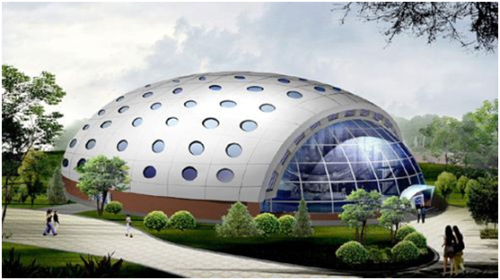- CURRENT LOCATION: HOME
- >> Tourism
- >> Attractions in Cities
- >>
- Xi'an
Museum Garden of Northwest Agriculture and Forestry University
2021-10-19 17:28:00 , Source : The Government Website of Shaanxi Province
The Museum Garden is located inside the south campus of the Northwest Agriculture and Forestry (A & F) University in Yangling Agricultural Hi-tech Industries Demonstration Zone, 51 miles (82 km) to the west of Xi’an. Including five museums and several outdoor gardens, this is an important agriculture science base integrating the functions of teaching, scientific research and science popularization. Covering an area of 33 acres, it is the first and largest agriculture-themed museum garden in China and the first AAAA scenic spot in Yangling, systematically showing the agricultural science and technology knowledge and the agricultural achievements of China.
A large number of precious specimens are kept in the garden, including 1.2 million insect specimens, 550,000 million plant specimens, and hundreds of thousands of animal specimens. Over 50,000 ancient books on agricultural history are also kept. All these exhibits are well categorized and displayed in the five museums (on insects, animals, plants, soil and agricultural history) as well as the Butterfly Garden, Arboretum and some special categorized botanical gardens.
Insect Museum
The total architectural floor area of the Insect Museum reaches more than 2.5 acres (10, 000 square meters), being the biggest and the most comprehensive insect museum in the world. Butterflies and other insects are bred there for audiences to watch.
Animal Museum
The total architectural floor area of the Animal Museum is about 1 acre (4,300 square meters), with over 8,000 pieces of various precious specimens in it. According to the overall display content, it is divided into eight exhibition halls respectively themed on the origin of life and evolution of animals, rare animals, pet and ornamental animals, the structure and function of animal body, animal breeding and human civilization, animal diseases and human health, animal production and the ecological environment, and animal biotechnology.
Plant Museum
This museum is made up of two parts: indoor exhibition halls and the greenhouse, with a total area of 2,392 square yards (2,000 square meters). There are four indoor exhibition halls which respectively themed on the secrets of plants, plants and environment, varieties of plants as well as plants and humans. The greenhouse mainly introduces main groups of plants and varieties of interesting plants. In addition, there are hundreds of flowers and plants from around the world.

It also collects about 550,000 pieces of herbariums from northwest, north and southwest of China, being one of the most abundant herbariums in China. The herbariums in it cover all groups of lichen, moss, ferns, gymnosperms and angiosperms, with over 300 pieces of plant specimens and over 30,000 photos of plants in it.
Soil Museum
The Soil Museum, in the same building of the Plant Museum, has collected typical soil profiles including monolith, miniature boxed specimens and shaped specimens from all over China. In addition, there are some photos and text materials which reflect the characteristics of soil of other countries.
The museum is formed by four exhibition halls respectively showing the formation and evolution of soil, the soil classification and distribution in China, the soil profile of China and the world as well as the relationships among soil, the environment and human.
Museum of Chinese Agricultural History
This museum covers an area of 4,784 square yards (4,000 square meters). It is divided into six halls displaying China’s agriculture development achievements in historical sequence: primitive times (before 2100 B.C.), the three dynasties (2100 B.C. - 206 B.C.), the Han (202 BC - 220 AD) and Tang (618 - 907) Dynasties, the Song (960 - 1279) and Yuan (1271 - 1368) Dynasties, the Ming (1368 - 1644) and Qing (1644 - 1911) Dynasties and modern times.
Butterfly Garden
Butterfly Garden, the outdoor display part of the Insect Museum, is the largest garden in China for releasing butterflies. Over 20 kinds of host plants and 30 kinds of honey plants for butterflies as well as 10 kinds of ornamental plants are planted there. You may also have the chance to release butterflies during late April to mid October, but you’d better visit there on sunny days especially in spring for all flowers begin to blossom then. Many tourists buy butterfly specimens as gifts.
Arboretum and Special Categorized Botanical Gardens
The Arboretum occupies an area of nearly 16 acres (100 mu), with 98 families, 281 genera and 603 species of plants coming from both north and south of China.
There are some special categorized botanical gardens, including Chinese herbal garden, grain garden, peony garden, herbaceous flower garden and perennial flower garden.

Admission Fee | CNY 60 CNY 30 (Student with student ID) |
Opening Hours | 9:00-17:00 |
Best Time to Visit | sunny days in spring or autumn |
Transportation | 1. Take train K5, K896, K897, K8151, D5087, K1363 or K591 from Xi’an Railway Station to Yangling Railway Station. Walk 218 yards (200 meters) towards west. 2. Take high speed bus from Xi’an West Passenger Station to Yangling Bus Station. Walk 109 yards (100 meters) towards the west. |

Government Organizations



Other Links

Copyright@www.shaanxi.gov.cn All Rights Reserved
Registration Number:陕ICP备10004160号
